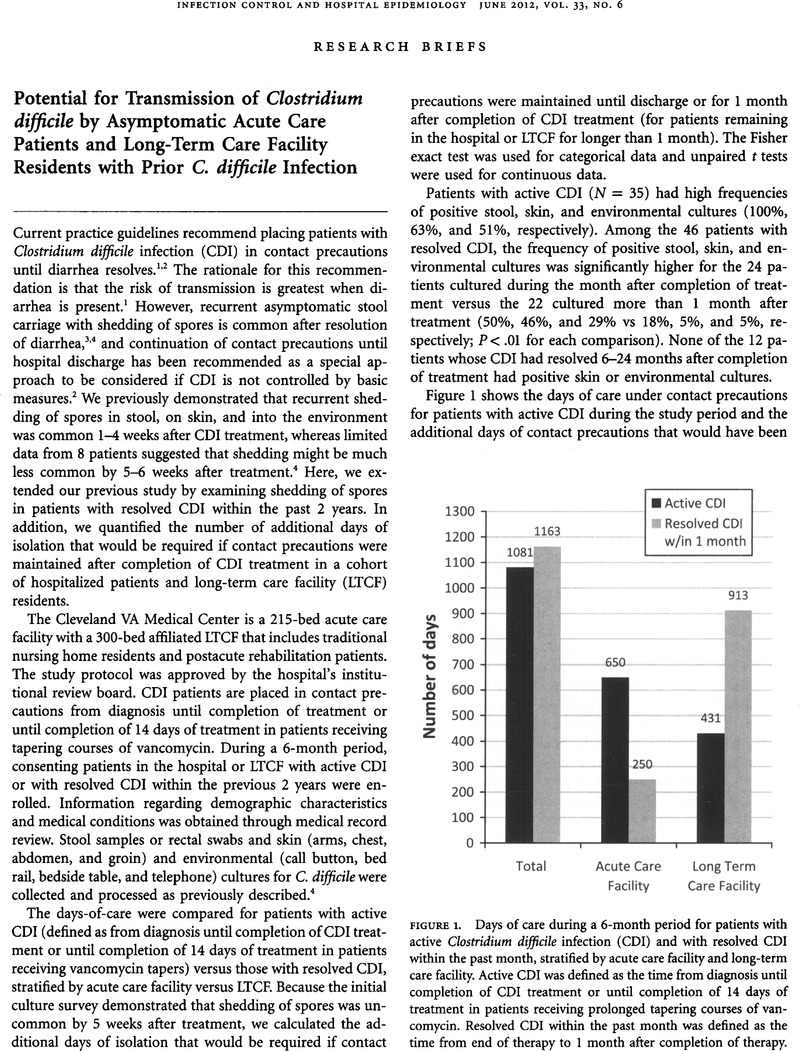Crossref Citations
This article has been cited by the following publications. This list is generated based on data provided by Crossref.
Eyre, David W.
Cule, Madeleine L.
Wilson, Daniel J.
Griffiths, David
Vaughan, Alison
O'Connor, Lily
Ip, Camilla L.C.
Golubchik, Tanya
Batty, Elizabeth M.
Finney, John M.
Wyllie, David H.
Didelot, Xavier
Piazza, Paolo
Bowden, Rory
Dingle, Kate E.
Harding, Rosalind M.
Crook, Derrick W.
Wilcox, Mark H.
Peto, Tim E.A.
and
Walker, A. Sarah
2013.
Diverse Sources of C. difficile Infection Identified on Whole-Genome Sequencing.
New England Journal of Medicine,
Vol. 369,
Issue. 13,
p.
1195.
Jury, Lucy A.
Sitzlar, Brett
Kundrapu, Sirisha
Cadnum, Jennifer L.
Summers, Kim M.
Muganda, Christine P.
Deshpande, Abhishek
Sethi, Ajay K.
Donskey, Curtis J.
and
Popoff, Michel R.
2013.
Outpatient Healthcare Settings and Transmission of Clostridium difficile.
PLoS ONE,
Vol. 8,
Issue. 7,
p.
e70175.
Wiuff, Camilla
Murdoch, Heather
and
Coia, John E
2014.
Control ofClostridium difficileinfection in the hospital setting.
Expert Review of Anti-infective Therapy,
Vol. 12,
Issue. 4,
p.
457.
Gupta, Swati B.
and
Dubberke, Erik R.
2014.
Overview and changing epidemiology of Clostridium difficile infection.
Seminars in Colon and Rectal Surgery,
Vol. 25,
Issue. 3,
p.
118.
Furuya-Kanamori, Luis
Marquess, John
Yakob, Laith
Riley, Thomas V.
Paterson, David L.
Foster, Niki F.
Huber, Charlotte A.
and
Clements, Archie C. A.
2015.
Asymptomatic Clostridium difficile colonization: epidemiology and clinical implications.
BMC Infectious Diseases,
Vol. 15,
Issue. 1,
Nagaraja, Aarathi
Visintainer, Paul
Haas, Janet P.
Menz, Jonathan
Wormser, Gary P.
and
Montecalvo, Marisa A.
2015.
Clostridium difficile infections before and during use of ultraviolet disinfection.
American Journal of Infection Control,
Vol. 43,
Issue. 9,
p.
940.
Donskey, Curtis J.
Kundrapu, Sirisha
and
Deshpande, Abhishek
2015.
Colonization Versus Carriage of Clostridium difficile.
Infectious Disease Clinics of North America,
Vol. 29,
Issue. 1,
p.
13.
Jump, Robin L. P.
and
Donskey, Curtis J.
2015.
Clostridium difficile in the Long-Term Care Facility: Prevention and Management.
Current Geriatrics Reports,
Vol. 4,
Issue. 1,
p.
60.
Shrestha, Subarna K.
Sunkesula, Venkata C.K.
Kundrapu, Sirisha
Tomas, Myreen E.
Nerandzic, Michelle M.
and
Donskey, Curtis J.
2016.
Acquisition of Clostridium difficile on Hands of Healthcare Personnel Caring for Patients with Resolved C. difficile Infection.
Infection Control & Hospital Epidemiology,
Vol. 37,
Issue. 4,
p.
475.
Awali, Reda A.
Kandipalli, Deepthi
Pervaiz, Amina
Narukonda, Sandhya
Qazi, Urooj
Trehan, Naveen
and
Chopra, Teena
2016.
Risk factors associated with interfacility transfers among patients with Clostridium difficile infection.
American Journal of Infection Control,
Vol. 44,
Issue. 9,
p.
1027.
Balsells, Evelyn
Filipescu, Teodora
Kyaw, Moe H.
Wiuff, Camilla
Campbell, Harry
and
Nair, Harish
2016.
Infection prevention and control of Clostridium difficile: a global review of guidelines, strategies, and recommendations.
Journal of Global Health,
Vol. 6,
Issue. 2,
Donskey, Curtis J.
2017.
Clostridium difficile in Older Adults.
Infectious Disease Clinics of North America,
Vol. 31,
Issue. 4,
p.
743.
Ponnada, Suresh
Guerrero, Dubert M.
Jury, Lucy A.
Nerandzic, Michelle M.
Cadnum, Jennifer L.
Alam, M. Jahangir
and
Donskey, Curtis J.
2017.
Acquisition of Clostridium difficile Colonization and Infection After Transfer From a Veterans Affairs Hospital to an Affiliated Long-Term Care Facility.
Infection Control & Hospital Epidemiology,
Vol. 38,
Issue. 9,
p.
1070.
Gupta, Swati B.
and
Dubberke, Erik R.
2018.
Reprint of: Overview and changing epidemiology of Clostridium difficile infection.
Seminars in Colon and Rectal Surgery,
Vol. 29,
Issue. 4,
p.
206.
Banach, David B.
Bearman, Gonzalo
Barnden, Marsha
Hanrahan, Jennifer A.
Leekha, Surbhi
Morgan, Daniel J.
Murthy, Rekha
Munoz-Price, L. Silvia
Sullivan, Kaede V.
Popovich, Kyle J.
and
Wiemken, Timothy L.
2018.
Duration of Contact Precautions for Acute-Care Settings.
Infection Control & Hospital Epidemiology,
Vol. 39,
Issue. 2,
p.
127.
Donskey, Curtis J.
Sunkesula, Venkata C. K.
Stone, Nimalie D.
Gould, Carolyn V.
McDonald, L. Clifford
Samore, Matthew
Mayer, JeanMarie
Pacheco, Susan M.
Jencson, Annette L.
Sambol, Susan P.
Petrella, Laurica A.
Gulvik, Christopher A.
and
Gerding, Dale N.
2018.
Transmission ofClostridium difficilefrom asymptomatically colonized or infected long-term care facility residents.
Infection Control & Hospital Epidemiology,
Vol. 39,
Issue. 8,
p.
909.
Rubin, Zachary A.
Martin, Elise M.
and
Allyn, Paul
2018.
Primary Prevention of Clostridium difficile-Associated Diarrhea: Current Controversies and Future Tools.
Current Infectious Disease Reports,
Vol. 20,
Issue. 9,
Luk, Shik
Ho, Alex Yat Man
Chan, Eliza Hoi Ying
Tsang, Iris Hoi Ling
Ng, Tak Keung
To, Wing Kin
Choi, Kin Wing
and
Wong, Andrew Tin Yau
2018.
High Prevalence and Frequent Acquisition of Clostridium difficile Ribotype 002 Among Nursing Home Residents in Hong Kong.
Infection Control & Hospital Epidemiology,
Vol. 39,
Issue. 07,
p.
782.
Fuchs, Beth Burgwyn
Tharmalingam, Nagendran
and
Mylonakis, Eleftherios
2018.
Vulnerability of Long-Term Care Facility Residents to
Clostridium Difficile
Infection Due to Microbiome Disruptions
.
Future Microbiology,
Vol. 13,
Issue. 13,
p.
1537.
Andersen, Bjørg Marit
2019.
Prevention and Control of Infections in Hospitals.
p.
755.



